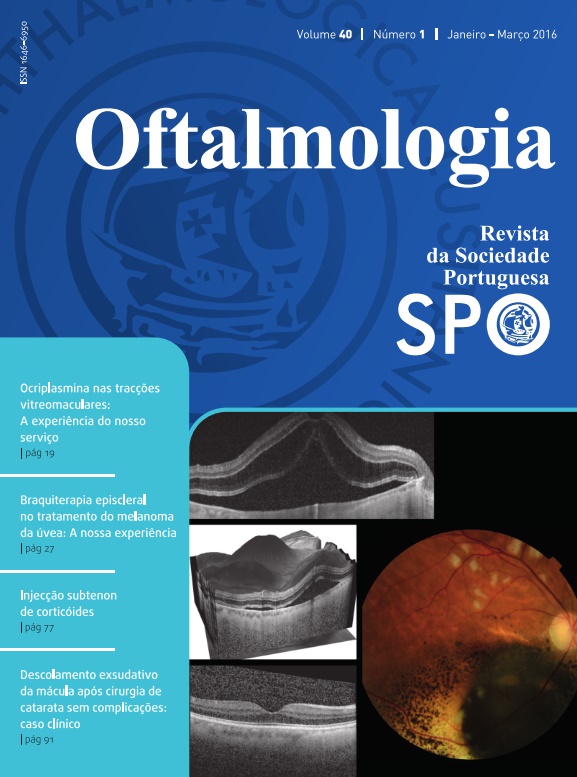EFFICACY AND PROGRESSION OF MACULAR ATROPHY AFTER SEVEN YEARS OF TREATMENT WITH RANIBIZUMAB: THE MYOPIC SEVEN-UP
DOI:
https://doi.org/10.48560/rspo.7532Palavras-chave:
Miopia patológica, neovascularização coroideia, atrofia macular, ranibizumab, acuidade visual.Resumo
PURPOSE: To assess the seven-year efficacy of intravitreal ranibizumab (IVR) in the treatment of myopic choroidal neovascularization (mCNV), and to estimate the progression of macular atrophy. MATERIAL AND METHODS: Retrospective study with cross-sectional evaluation. Medical records of high myopic patients with mCNV treated with IVR with minimum follow-up of 84months were analysed. A final cross-sectional evaluation included best corrected visual acuity (BCVA), colour fundus photography, spectral-domain optical coherence tomography (SD-OCT) and fundus autofluorescence (FAF) imaging. RESULTS: Thirteen eyes of 13 patients with an average follow-up of 96.6±5.4 months were included. After a mean number of 8.5±4.5 IV injections of ranibizumab, BCVA at baseline and on the last visit was 48.4±16.7 letters (L) and 45.2±26.8 L, respectively (p=0.6).VA improved up to the third year (56.7±21.0 L) and decreased ever since. Regarding the last visit, 4 patients (30.8%) reached a significant visual gain (BCVA >5 L), 2 patients (15.4%) maintained visual acuity (range between -5 and 5L), and in 7 patients (53.8%) more than 5 L loss was reported. Concerning macular atrophy area, we noticed an increase, on average 4.6±3.2mm2, meaning a significant progression (p=0.002). The mean central macular thickness ranged from 304.9±116.5 µm at baseline to 360.5 ± 89.1 µm on the last visit (p> 0.05). CONCLUSIONS: Ranibizumab is an effective drug in the treatment of CNV, secondary to pathologic myopia, stabilizing or even improving BCVA. However it does not seem to prevent subsequent macular atrophy which could be related with progressive VA loss.
Downloads
Downloads
Ficheiros Adicionais
Publicado
Como Citar
Edição
Secção
Licença
Não se esqueça de fazer o download do ficheiro da Declaração de Responsabilidade Autoral e Autorização para Publicação e de Conflito de Interesses
O artigo apenas poderá ser submetido com esse dois documentos.
Para obter o ficheiro da Declaração de Responsabilidade Autoral, clique aqui
Para obter o ficheiro de Conflito de Interesses, clique aqui





